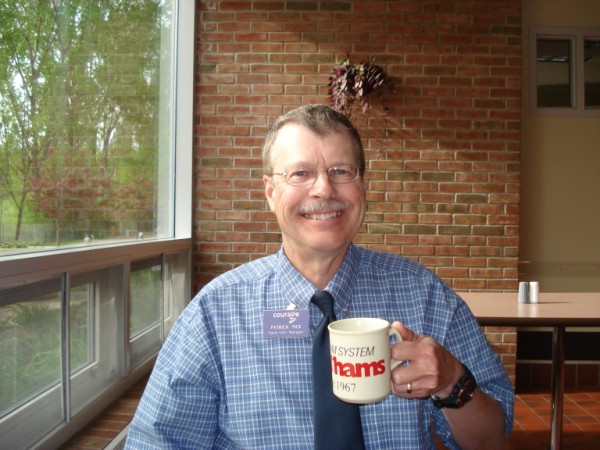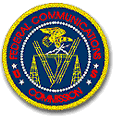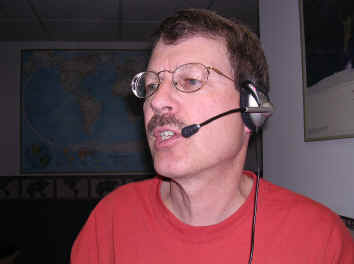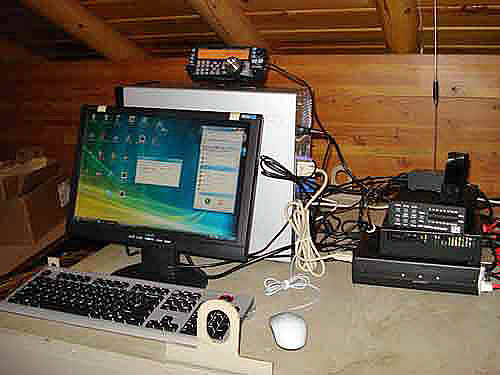Welcome to Handiham World!
 End-of-year greetings from all of us at Handihams! At this time of the year, it is traditional to over all the old stories from the previous year. Guess what? I''m not going to do that, thus sparing you from the tedium of one more retrospective. Consider it my New Year''s gift to all of our readers and listeners. It isn''t that important stuff hasn''t happened over the previous year, it''s just that too many media outlets and editors cobble together old stories so that they don''t have to do any work on current news at the end of the year. Me? I would rather just make this a short and to the point issue as we look forward to 2009. You''re welcome.
End-of-year greetings from all of us at Handihams! At this time of the year, it is traditional to over all the old stories from the previous year. Guess what? I''m not going to do that, thus sparing you from the tedium of one more retrospective. Consider it my New Year''s gift to all of our readers and listeners. It isn''t that important stuff hasn''t happened over the previous year, it''s just that too many media outlets and editors cobble together old stories so that they don''t have to do any work on current news at the end of the year. Me? I would rather just make this a short and to the point issue as we look forward to 2009. You''re welcome.
There are several new handiham-related things to look forward to early on in the new year.
The first item of business is related to our Handiham Nets:
Beginning January 1, Howard, KE7KNN, our Net Manager, will begin taking counts of the stations checked in for each net session. This information can be sent as official National Traffic System traffic, if the net control station so desires. This is the way it is done on the PICONET, which I will get to in a minute. The idea of counting stations checking in and coming up with the total to pass on to the Net Manager will help us to get an idea of how healthy the net really is and whether it is growing or shrinking. Furthermore, sending the total as official traffic will help gain all of us more experience with NTS. For example, let''s say I am the net control station and I tally 20 stations that checked in during my session of the net. At the end of the net, I would prepare a piece of traffic for Howard that would go something like this:
This is message number one routine from WA0TDA, current time and date, to KE7KNN. Station total 20. Signature Pat
I know this isn''t the exact formal style of the ARRL radiogram form, but it should be good enough to get things done. Howard will probably be listening to the net and will take the traffic directly, or you can use the radiogram format to include his e-mail address for delivery, which is ke7knn@arrl.net. Most stations handling traffic will keep some kind of log so that they don''t lose count of which message number they should be using.
As long as we are talking about the nets, I want to share with you a message from our Net Manager:
Hi Pat,
Your e-letter has me listed as the net manager, but you have Arlene''s call sign! Remember, she''s the pretty one! My call sign is KE7KNN. I have noticed on the net that we are getting a lot of interference from one station using JAWS. Anyone using automated speech such as JAWS needs to turn it down when they are on the net. Also, we need people to be careful not to overdrive their microphones. I''ll be out there listening each day. You can email me at KE7KNN@arrl.net. That is for everyone for the nets.
Thanks, Howard
Pat says: My apologies to Howard for getting his callsign wrong in the previous edition. Darn it, I was hoping to make it through the entire year of 2008 without a single mistake. One of the things I am going to do over the coming months, and you can call this a New Year''s resolution if you like, is to tune around the bands and try to really get to know what is going on on the frequencies that I seldom visit. It has been my habit to consistently return to the same old frequencies, usually at the same time of day. Who knows what I might be missing? Furthermore, I just may get some ideas about when and where to build new handiham nets. Keep in mind that we are open to suggestions as to which high frequency nets we want to keep during 2009. The best way to form a solid opinion is to try really hard to listen at different times and on different frequencies to learn exactly what is going on. Keep an open mind about this, and send your suggestions to either Howard or me.
The next item of business is the remote base:
We are still on track to bring the remote base online for member use in early 2009. Stan is still working on the software, but we expect to begin an orderly assignment of passwords to members in the first quarter of 2009. There is still quite a lot to do on the instruction pages, and frankly I am a bit worried about getting inundated with tech support requests. I do need to make the instruction pages more detailed so that our users will be able to figure out as much as possible on their own. One of the things you will be able to do with the remote base is to check in to the PICONET, a very active daily HF net with a long time association with the Handihams.
The PICONET has a history paralleling the handiham system, having started in the late 1960s and continuing to this day as a successful net. It is worth looking at because it has had staying power in the face of a great deal of technological and social change in amateur radio. The tenor of the net is one of camaraderie and informality with a modest helping of public service and a friendly net control station. Net control station duties are shared among a list of volunteers who take "their hour" on a particular day of the week. The system has evolved over the decades as a practical method to avoid any one person being tasked with too many hours and too much control. Everyone understands that each net control station has a different personality. A count of stations checking in is maintained and passed as a piece of traffic at the end of each hour. Because the net is on 3.925 MHz, a frequency band covered by most out-of-the-box commercial wire antennas and verticals, there are few technical problems for participants setting up a station. An annual get-together reinforces the social aspect of the net. There is a website. A "blank hour" is rare.
At last September''s PICONET get-together I met friends I''ve known for years, but there were also some teenagers just getting started in amateur radio. The "marketing department" even scored newspaper coverage with photos. To all intents and purposes, the PICONET is alive and well and serves as a good example of an entity that maintains the correct mix to stay that way. It will be fun for Handiham members far and wide to be able to check in via the remote base.
For Handiham World, I''m Patrick Tice, wa0tda@arrl.net



 As we have been reporting, the Handiham Remote Base HF station is on track to go live to member use in early 2009. Stan, W4MQ, is working on some software updates to make the process of setting up and operating the rig control software easier for our blind Handiham members. Our thanks to him and to our beta testers, and especially to Lyle, K0LR, project engineer, and Joe, N3AIN, our expert JAWS volunteer and TS-480 user, for working with Stan to identify issues with the accessibility of the system.
As we have been reporting, the Handiham Remote Base HF station is on track to go live to member use in early 2009. Stan, W4MQ, is working on some software updates to make the process of setting up and operating the rig control software easier for our blind Handiham members. Our thanks to him and to our beta testers, and especially to Lyle, K0LR, project engineer, and Joe, N3AIN, our expert JAWS volunteer and TS-480 user, for working with Stan to identify issues with the accessibility of the system.
 I could be listening to the repeater, reading a newspaper, checking out a story online... Sometimes something just pops out at me. This morning, for example, I was checking through my email, and reading through the FCC's daily summary bulletin. One item caught my attention:
I could be listening to the repeater, reading a newspaper, checking out a story online... Sometimes something just pops out at me. This morning, for example, I was checking through my email, and reading through the FCC's daily summary bulletin. One item caught my attention: 






 Emergency responders learn something very important in their training: how to deal with complacency. While some of us are better at learning than others, everyone is affected by complacency. A perfect example of how we become complacent is that we go a long happily for many years without having to deal with a disaster, in the meantime failing to keep our radio equipment in good working order, failing to keep our go kits up to date, failing to have a family plan for dealing with emergencies, failing to stock extra water and batteries, and so on. It is really hard work to fight complacency. Things have gone well for so long that we simply assume the rest of today, tomorrow, the next day, and the next week will all go just as perfectly well.
Emergency responders learn something very important in their training: how to deal with complacency. While some of us are better at learning than others, everyone is affected by complacency. A perfect example of how we become complacent is that we go a long happily for many years without having to deal with a disaster, in the meantime failing to keep our radio equipment in good working order, failing to keep our go kits up to date, failing to have a family plan for dealing with emergencies, failing to stock extra water and batteries, and so on. It is really hard work to fight complacency. Things have gone well for so long that we simply assume the rest of today, tomorrow, the next day, and the next week will all go just as perfectly well.



